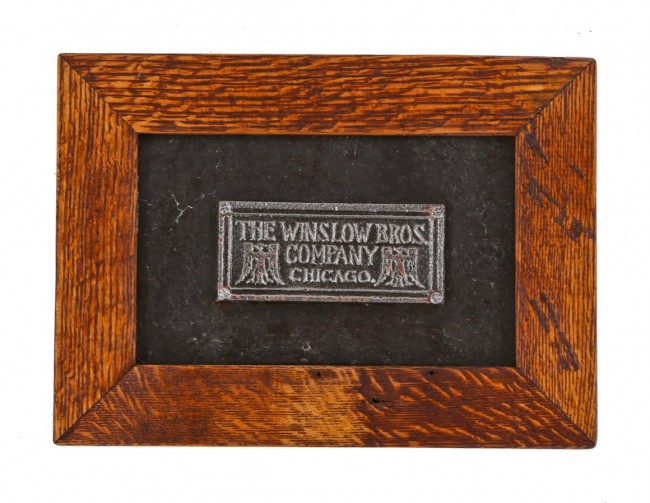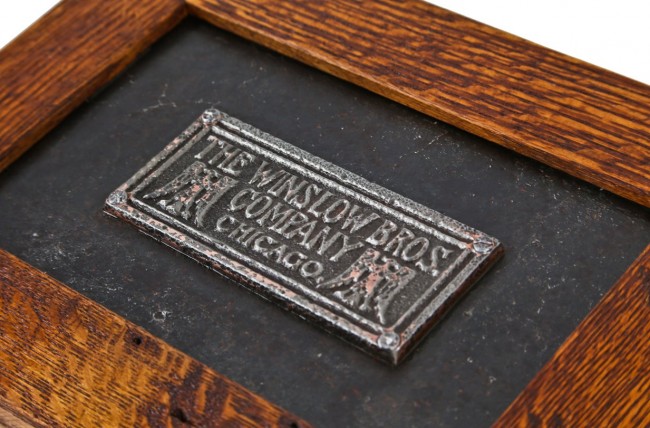
late 19th century winslow brothers company interior plymouth building staircase riser fragment with ornamental cast iron manufacturers plaque – winslow brothers company, chicago, il.
51-20462-14
Category
Chicago BuildingsAbout This Item
remarkably rare and hard to find all original late 19th century manufacturer or builders plaque designed and fabricated by the winslow brothers company foundry, chicago, il. the diminutive plaque was discovered on the backside of plymouth building staircase riser panel. both the ornamented plaque and riser fragment were carefully cleaned and mounted in a mitered joint quartered oak wood frame with the wood salvaged from the chicago athletic association building designed by architect henry ives cobb. the c. 1898 plymouth building, located between the old colony and manhattan buildings, was designed by simeon b. eisendrath. the plaque does contain a partially intact copper-plated finish. the bottom left and right corner contains two winged birds identical in design. the winslow brothers foundry (specializing in ornamental iron and bronze work) was founded around 1887 by brothers william and francis winslow. within a very short time thereafter, the winslow brothers would become one of the most accomplished foundries; outfitting numerous notable buildings and residences with skillfully executed metal ornament well into the 20th century. as early as 1881 william winslow was involved in foundry work when he joined the prestigious helca iron works of new york as office man and later as partner in 1883. helca would later receive the commission to supply any and all ornamental ironwork (under winslow’s supervision) for burnham and root’s rookery building in chicago. interestingly, the winslow brothers would later install elevator systems in the rookery when they briefly ventured into elevator manufacturing. in 1885 winslow moved to chicago and joined e.t. harris to form the firm of harris and winslow, manufacturers of ornamental iron and bronze. after harris retired, winslow and his brother francis established the winslow brothers company, which was first listed in a chicago directory in 1887, at 99-109 west monroe street, with william as president and francis as secretary and treasurer. the winslow firm was represented at numerous international exhibitions, such as the world’s columbian exposition of 1893, where they were awarded eight metals. in 1900, they were awarded the grand prix, two gold medals and three honorable mentions at the exposition universelle in paris, france. the firm’s rapid growth led to the establishment of offices or selling agencies in new york baltimore, pittsburgh, new orleans, minneapolis, los angeles kansas city, and san francisco. according to several heavily illustrated catalogs for the winslow brothers, their foundry produced some of the finest bronze and ironwork for several building commissions across the country. their work included stair balusters, signage, elevator grilles, exterior storefront ornament, lighting fixtures and other metal ornament used within the interiors and exteriors of commercial buildings and residences. in 1905 winslow brothers constructed a new manufacturing plant consisting of six buildings, one and two storied, covering 175,00 square feet of floor space. it was built on the tract of land bounded by forty-sixth and forty-seventh avenues and van buren and harrison streets, and cost $150,00-200,00 to build. raeder & coffin were the architects on record. winslow brothers continued to thrive in the fabrication of customized architectural metalwork throughout the country well into the early 20th century. world war i dramatically changed both their operation and output, where nearly all of their divisions within the newly built plant were now focused on a “patriotic campaign” in the form of a seemingly endless fabrication of artillery shells. a catalog and/or special booklet from 1919 (author’s collection) is completely devoted to operations surrounding the war effort, with absolutely no mention of their former life as a highly specialized ornamental metal foundry. in fact, the cover of the catalog contains a single graphic, in the form of a lightly embossed metallic gold shell casing and nothing more. when the war drew to a close, the winslow brothers gradually shut down any and all remaining operations. the pressure of maintaining day-to-day operations, coupled by labor unrest were some of the factors leading to their decision to close down the plant. the drawn out shut down and selling of the company’s assets occurred between 1919 through the early 1920’s.





